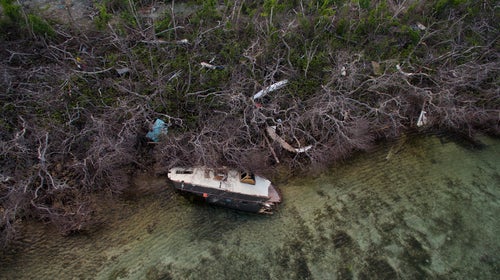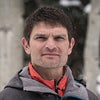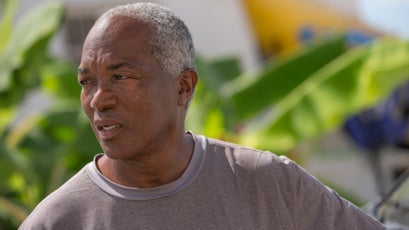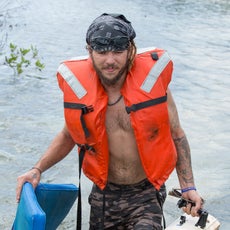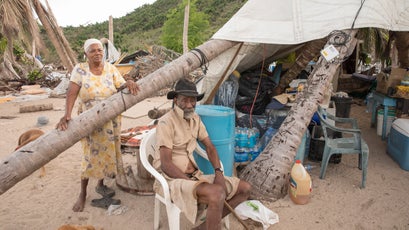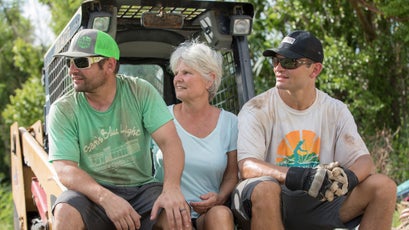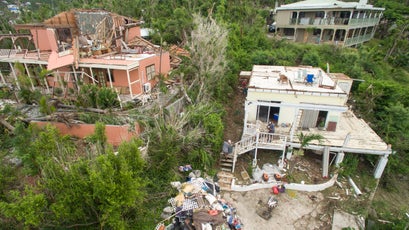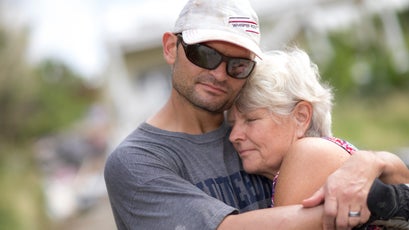Hurricane Irma Destroyed My Childhood Paradise
Devon O’Neil watched from a distance as Irma—one of the strongest storms to ever hit land—battered the Caribbean island of St. John with 200-mile-per-hour winds. Two months later, he returned to the place where he grew up to help clear the wreckage and process the destruction of his former home.
New perk: Easily find new routes and hidden gems, upcoming running events, and more near you. Your weekly Local Running Newsletter has everything you need to lace up! .
As a kid, you can’t control where you grow up. To land somewhere like St. John, in the U.S. Virgin Islands, takes luck—and in my case an adventurous mother.
My fraternal twin brother, Sean, and I were five years old when our mom decided that she was tired of commuting from Westport, Connecticut, to New York City. So in December 1985, she and her boyfriend bought a 41-foot sailboat named Yahoo, we packed everything we owned into 19 duffel bags, and we headed south.
St. John, half of which is covered by , offered singular beauty—and plenty of places to anchor our new floating home. Mom took a job as a landscaper in Fish Bay and eventually got her real estate license. Sean and I fell in with a rat pack of kids who congregated after school to play tackle football, catch tarantulas and lizards, and crawl under barroom floors in search of quarters. We grew up boogie boarding and surfing on the south shore. One day we took turns reeling in a 350-pound shark off the west end of Jost Van Dyke, next door in the British Virgin Islands.
Download for your iPhone to listen to more longform titles.
After two years on the boat, Mom bought a house. A house that, on September 6, 2017, was completely destroyed by Hurricane Irma. At the time, my mother was on the mainland for a wedding and a visit with Sean and me in Colorado, where we both live with our families. Four days after the storm, we found a YouTube video with aerial footage of our neighborhood. It was annihilated; I didn’t recognize our home, a modest two-story structure that had survived hurricanes for 30 years. It looked like someone had shot a missile into it. So did our neighbors’ houses. I watched the video five times. Despite studying the footage, which covered at least a quarter mile in all directions, I could not locate our roof.
It had been more than 15 years since I’d lived on St. John, but I still considered it home. It’s where I learned about the world, everything from fishing to race. When we were nine, my brother and I spent an entire spring glued to a chain-link fence watching St. John’s all-black Little League team practice. The West Indian coaches, former pro prospects Orville “Chopper” Brown and Terry “Chino” Chinnery, asked if we’d like to join the team the following year. We did. On September 16, 1989, while practicing in the island’s main town of Cruz Bay, I got hit by a pitch and broke my elbow. As the doctor wrapped it in a cast, he said, “Have you heard about the storm coming?”
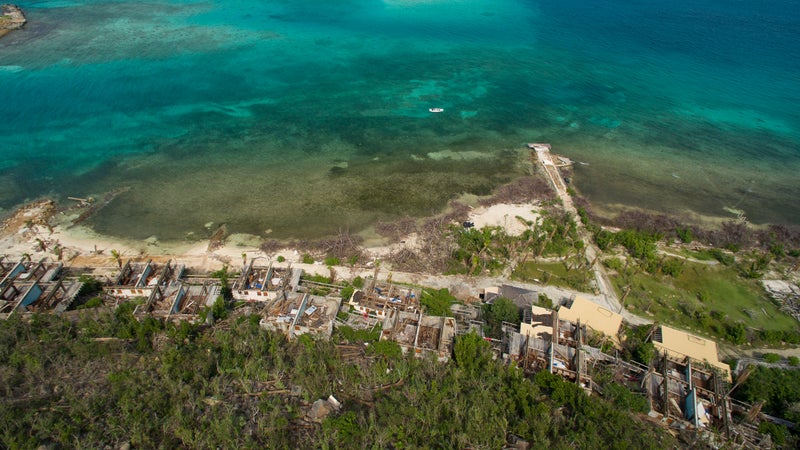
He said it was called Hugo and that the territory was in line for a direct strike. The Virgin Islands have a long, fatal history with tropical cyclones. The first recorded major hurricane hit the island in 1697. Devastating storms followed in 1772, 1819, 1867, and 1916. It had been decades since a legitimate threat had materialized.
By then we were in our new house a half mile above Cruz Bay; other residents live in small communities scattered above bays and beaches. We were oblivious to the storm’s power. Instead of installing hurricane shutters or armor screens, like people do now, we duct-taped an X over each of the six sliding glass doors and sat on our living room couch as Hugo roared through with 150-mile-per-hour sustained winds. We watched a neighbor’s roof peel off, a shed get picked up by a tornado, and a restaurant’s roof slam into our yard like a kite. When the glass started to bow, Mom told us to hide under the bed.
In 1995, Hurricane Marilyn landed another roundhouse. Sean and I were in Connecticut when it hit; Mom rode out the storm on a boat in Hurricane Hole, a sheltered bay that offers some protection from the wind. Though the boat held its position, people who hunkered down in more vulnerable locations on shore still insist that the winds were substantially stronger than the 115-mile-per-hour forecast.
I recall images from those storms, but the damage I saw on the Irma video was in a class by itself—three or four times as bad as Hugo and Marilyn combined, locals estimated. “The forces were just incomprehensible compared with previous storms,” says Rafe Boulon, a St. John native and retired scientist whose great-grandfather opened the U.S. Weather Bureau office on Puerto Rico in the early 1900s. “Some places lost probably 10,000 years of sand and vegetation in a matter of three hours.”
As soon as IrmaÃ˝formed as a tropical storm off the west coast of Africa on August 30, it grabbed scientists‚Äô attention. Weak upper-level winds over the Atlantic and sea-surface temperatures that were two degrees warmer than average made for an ominous mix as the storm moved toward the Caribbean.
“It’s amazing how much difference just one or two degrees can make at that water temperature in terms of how strong a hurricane can get,” says Jay Hobgood, an associate professor of atmospheric science at Ohio State University who tracked Irma and has been studying hurricanes since the 1970s.
Despite a roughly 400-mile diameter, Irma had to thread a needle to inflict catastrophic damage on populated places. Most destruction occurs in a hurricane’s eyewall, a band of brutally violent wind spinning counterclockwise around the eye; beyond that, winds drop off quickly. This creates a 40-to-60-mile-wide path where you don’t want to be. Almost all hurricanes pass between Trinidad, just north of South America, and Bermuda. But most of them track north of the U.S. Virgin Islands, which have only a 3 percent chance of being hit by a hurricane that’s Category 3 or stronger.
Irma soon grew to Category 5, with maximum sustained winds of 185 miles per hour—the second-highest speed on record for an Atlantic hurricane. The day before it hit, Chopper got a call from his son, ­Okyeame, who works in intelligence for the U.S. Navy and is Sean’s and my godson. At 61, Chopper is built like a defensive end and remains as imposing as when he served as the island’s unofficial patriarch, someone who mothers would bring their sons to for discipline and direction. Okyeame told his father that he had researched the storm and it was a monster—nothing like it had hit St. John in generations, if ever. Chopper felt a wave of fear wash over him.
Four days after the storm, we found a YouTube video with aerial footage of our neighborhood. It was annihilated.
The same day, I called my closest friend from childhood, Galen Stamford, who was living in the one-bedroom apartment on the first floor of my mom’s house with his wife and six-year-old daughter. Sean and I met Galen our first week in the Virgin Islands. He grew up to be one of the top surfers in the region and a beloved island figure. Like everyone else, he had been watching Irma’s advance with dread. “I don’t think your mom’s house is going to survive this one,” he said. He had decided to stay at a friend’s concrete house in Peter Bay, on the north side of the island, where the windows and doors would be protected by a large armor screen. They had stocked enough food and water to last three months.
Across the 20-square-mile island, the 4,000 residents finalized preparations of their own. In Rendezvous Bay, on the island’s south side, Carlos Di Blasi, a 53-year-old restaurant owner, had decided to ride out the storm in the house that he and his wife, Maria, had built 16 years earlier. It had one-foot-thick concrete walls and a roof made of corrugated tin, three-quarter-inch plywood, and half-inch cedar.
Sailors in the area frantically rushed to secure their boats. Longtime skipper Richard Benson, 66, buzzed around in his dinghy helping other people get ready, including his son, Daniel. Benson owned one of St. John’s iconic charter boats, the all-black, 84-foot “pirate ship” Goddess Athena. He had a long blond beard and gold teeth, and he was known for his stern temperament and reliability. He and Daniel had five boats to prep between them, but as they worked, Daniel was fighting a stomach bug that left him barely able to speak. “I felt terrible,” recalls Daniel, a 26-year-old artist and surfer. “All I wanted was to be with my dad and help him.”
Before Benson steered the Goddess Athena to Coral Bay on September 5, he did something that was rare for him: he admitted regret. “We should’ve sailed south two days ago,” he told a friend.
Benson didn’t have as many options as smaller-boat owners did for where to seek shelter. In Hurricane Hole, the National Park Service allots 105 spots across four bays where captains can clip onto a one-inch-thick chain strung across the ocean bottom. But boats longer than 60 feet aren’t allowed to use the chain, so Benson positioned the Goddess Athena in the shallower water and mud of Sanders Bay, across the harbor.
Just north of where Benson anchored, a 50-year-old lifelong sailor named Adam Hudson tied off his 27-foot Bristol, Solstice, in roughly the same spot he always did: in front of the old customhouse on the east side of the bay. The first time he rode out a major hurricane on the water—Hugo, when he was in his early twenties—Hudson escaped a pileup of boats by jumping into chest-deep water and wading to shore as raindrops shelled his skin. He and his dad watched their boat get pounded for the next eight hours, irreparably damaged. This time he figured he’d be fine, if for no other reason than he’d always been fine in this spot—the same rationale Benson seemed to be using.
The night before Irma struck St. John, it mowed down Barbuda—an island three times the size of St. John—leaving 95 percent of its buildings uninhabitable. St. John­ians who watched the radar that night were forced to accept a grim reality.
“Imagine you’re skydiving, and you pull the rip cord and nothing happens,” Daniel Benson says. “You look at the ground, and the glance that you and the ground exchange, that moment of imminence—that’s what it felt like.”
On the morning of September 6, the storm ramped up at different times in different places, but it happened quickly every­where. In Peter Bay, Galen and his storm mates—seven people and six dogs—observed an almost instantaneous change when the eyewall arrived at around 11:15 A.M. “It was like a snap of your fingers,” he said. “There was no warning. We went from 70- to 160-mile-per-hour winds like that. The bronze railings started to whistle. You could hear ceramic roof tiles getting ripped off one by one.”
Five miles south, Carlos Di Blasi and his family lounged in a bedroom watching a movie, wondering why it was so quiet. Their house faced east and was tucked against a mountain, sheltered from the west winds. Until 12:30 P.M., you could have heard a quarter hit the floor. Then a big gust shook the house, and Di Blasi decided that they should move downstairs to a more secure room. He walked to the closet to get his shoes as Maria and their 11-year-old son, Alejo, looked out the window.
Bang! A deafening explosion rang out—suddenly the dark room was light. Di Blasi looked at his 15-year-old son, Mateo. A long two-by-six beam had pierced the roof like a javelin and missed his son’s head by inches, spraying his hair with wood chips.
Bang! A second beam landed on the other side of Mateo. He stood there, frozen, as water gushed through the ceiling holes.
Bang! A third beam came through. Maria started screaming. The four of them raced downstairs to a bathroom under a concrete ceiling and listened as 11 more beams—ripped from another house by a tornado—­penetrated their roof.
At the other end of the island, in Coral Bay, six-foot waves crashed down on Hudson’s boat, breaking its mast. At 1 P.M., he felt an anchor line snap, and the boat started taking on water. He knew it was only a matter of minutes until it sank, so he grabbed his savings—$5,000 in cash that he kept in a drawer—crawled onto the bow, and waited until the pulpit disappeared into the water. Then he began to swim for his life, greenbacks in one hand, ball cap in the other.
He estimates that he swallowed a gallon of saltwater during the swim. He reached the shoreline, crawled up to a rock, and clung to it for five hours in the fetal position, shivering and slurping rainwater.
Several islanders say they felt an earthquake at the height of the hurricane. Water rose through sink and shower drains, then disappeared. Walls expanded and contracted. “I thought 10 percent of the people on island were going to die,” Daniel Benson told me. “I honestly thought that.”
Across most of St. John, the storm simmered down between 5 and 6 P.M. The eyewall had passed, and a hurricane’s outer bands usually bring more rain than wind. But high on Bordeaux Mountain, the island’s pinnacle at 1,283 feet, the fury was just ­beginning.
Debby Roberts-Liburd, a grandmother whose family lives on a remote plot above southern Lameshur Bay, counted seven tornadoes between 5:30 P.M. and 1 A.M. She had already watched three relatives’ houses get blown apart when her own roof flew away at 10:30 P.M. Then the wind sucked the toilet straight up and out of the bathroom.
“Ma,” yelled her son, L.J., “we cannot stay in this room, because we all will be sucked out.” As Debby hurried outside to take shelter on the lower floor, L.J. saw a tornado coming and knew she wouldn’t make it back inside before it arrived. He ran and grabbed her around the waist as she clung to a water drum. “Don’t look up,” he said.
The wind lifted Debby’s legs off the ground and shook her like a fish. “Just hold on, Ma!” L.J. said. “Don’t loose off, ’cause if you loose off, two of us gone!”
When she felt her grip slipping, Debby prayed. Please, Lord, don’t let anything cut off my hands. Almost instantly, she heard a ssssssip, and the air went still. She ran inside.
The morning after felt apocalyptic. Not a leaf remained; the islands were so brown that the color even showed up in images from NASA satellites. Bizarre sights filled the landscape. Chopper came out of his house to find his dog eating his cat. Boats were stacked on shore like sticks in a campfire. Desperation set in. Looters ripped out ATMs. My mom worried that her belongings would be ransacked before she got home. Galen heard stories of people getting robbed at gunpoint, and he began sleeping with a spear.
At first, some 2,700 residents were unaccounted for—more than half the population. “I was getting two to four messages a minute for a while,” says Jon Shames, president of St. John Rescue, a volunteer organization.
In the sailing community, boaters shared news of who they’d seen and who they hadn’t, in what is known as the Coconut Telegraph. It soon became evident that nobody could find Richard Benson or the Goddess Athena. Daniel Benson spent days using a jury-rigged VHF radio to try and hail his dad. He got no response, but he heard the Coast Guard trying, too, which gave him hope.
Unfortunately, the Atlantic hurricane season was far from over. Two weeks after Irma passed, Maria walloped St. Croix and Puerto Rico—major hubs for the relief effort on St. John. Even though St. John dodged a direct strike, its supply chain was broken.
Richard Benson’s fate remained a mystery for 19 days, until someone saw a British news story about an unidentified man who was found nine miles northeast of Coral Bay, on Tortola’s coast, the day after Irma. “Caucasian, between the ages of 60 and 70, medium build, 5'7 to 5'8 and 160 lbs,” read the description. “He had a long blond beard and hair and was wearing blue coveralls like that of a marine engineer when he was found.” Daniel took a helicopter to identify his father at the morgue. He was, remarkably, the only St. John resident to die during the storm.
Not long afterward, Daniel located the Goddess Athena—or at least the remaining 20 feet of her. The stern, one of 546 shipwrecks left by Irma in the U.S. Virgin Islands, had washed up inside the barrier reef at Johnson Bay, just southwest of Coral Bay. It was a skeleton. The steering wheel and helm were gone, and the interior was gutted except for a light bulb and a speaker. The only thing that Daniel found of his dad’s was his old underwater camera.
My mother arrived on St. John three weeks after Irma, the day the St. Thomas airport reopened. She spent long hours picking things out of the rubble, which she stored in her car, and doing laundry at a friend’s house where she was staying. She applied for FEMA aid. She got exhausted quickly and often.
Everyone kept asking what she was going to do, and she didn’t have an answer. Rebuilding at age 68 with a FEMA loan sounded daunting, but so did the alternative: leaving the island she loved.
I got my first view of St. John two months after Irma, on November 6. Sean and I joined Galen, two friends from Colorado, and my father-in-law to tear down our house to the foundation. Part of me feared the job, not for physical reasons but for emotional ones. Still, the rubble had sat long enough, and we knew Mom would need it gone if she decided to sell the land. (Before she paid off her mortgage five years ago, the bank required her to have hurricane insurance, which cost $18,000 a year. She got rid of the coverage once she settled the debt.)
It’s strange to take a sledgehammer to your childhood home—demolishing the kitchen counter and what’s left of your bedroom walls. But that was better than cleaning out the freezer, which had sat unopened for two months in 85-degree heat. Thousands of rotting maggots combined with shrimp scampi make a strong case for the world’s foulest smell.
As I broke down walls snared in vines, I couldn’t help but imagine how the house had come apart. Assuming that the roof went first, the west-facing wall must have been flattened by 200-mile-per-hour winds. The remaining walls likely collapsed after that, then the south deck and railings, everything swept into the bush.
Iguanas watched from the treetops as we shoveled soggy debris into buckets and piled it eight feet high in the driveway. In one shovelful, I collected a remote control, part of the kitchen table, a phone book, chunks of moldy drywall, and a bottle of vinegar. In the next, my high school ID, more moldy drywall, Ã˝ on DVD, and a Christmas card to ‚ÄúGram‚Äù from Sean‚Äôs kids.
I dug a box out of the mud that contained our grandparents’ Kodachrome slides from the 1950s. Mom found her Woodstock ticket stubs. We discovered a plastic bin full of a hundred framed photos from our childhood and hers, somehow sitting dry next to three bins full of water.
On the third day, a neighbor surveyed our work from his still standing deck. “See!” Mom shouted up to him. “I told you they’d come rescue me.” For the first time in weeks, she sounded hopeful.
Despite spending that week on St. John, I knew I had seen only a portion of Irma’s impact on the region. So in late November I returned, joining local photographer Steve Simonsen on his boat. We motored all over the British Virgin Islands, which neighbor St. John, visiting people who had survived the eye and were now left to rebuild.
One of our first stops was the world-­renowned Bitter End Yacht Club on the east side of Virgin Gorda, a 64-acre resort spread across a mile of sandy coastline. Sixty of its buildings—including 40 rental villas—were destroyed. “It has to be totally reimagined,” John Glynn, a marketing executive, told me.
We pulled up to the dock and met Henry Prince, a 20-year employee and Virgin Gorda native who guessed that it would take at least three years for Bitter End to look anything like it did before the storm. “You’re not going to rebuild it the way it was. You have to rebuild it for the new type of hurricane,” he said.
A long two-by-six beam had pierced the roof like a javelin and missed his son’s head by inches, spraying his hair with wood chips.
We headed across North Sound past Necker Island, where Sir Richard Branson has weathered every hurricane for the past 40 years. He told me that 300 of his private island’s 600 flamingos survived winds that broke his anemometer when they hit 210 miles per hour. We stopped for lunch at Leverick Bay, one of the most devastated communities, where four out of every five buildings had been blown apart. Marina manager Nick Willis was sipping a beer on his deck when I found him. He told me about the damage but also how Irma had brought out the best in people. Like the rich Czech guy from Nail Bay who had paid hundreds of locals $10 an hour to work on their homes after the storm. Or the man who had boated up to the marina and handed Willis $100, asking only that he give it to someone who needed it. “It just brings you to tears,” Willis said.
We drove around Tortola with Chino, my old baseball coach, who mentors island kids and lives in Cane Garden Bay, a port famous for its beachfront restaurants, all of which were destroyed. We saw where the ocean had ripped graves out of the earth in Carrot Bay and flipped a 99-ton ferry upside down on Jost Van Dyke. We gaped at a battered airplane fuselage—without its wings or tail—balanced atop a ruined hangar at the Beef Island airport. I heard rumors that the British military measured gusts up to 285 miles per hour. (The unofficial wind speed record is 318 miles per hour, set by a 1999 tornado in Oklahoma City.)
None of the sights, however, compared with what we found on Cooper Island, a tiny cay off the south shore of Tortola. As we neared a concrete dock, an old West Indian woman walked toward us holding a knife above her head. I got off the boat and approached her slowly, introducing myself and asking if I could talk to her about Irma. “Of course. Come in!” she said. She led me and Simonsen toward a makeshift white tent—actually a sail draped over some coconut trees. A frail-looking man limped along the beach to meet us.
Jean and John Leonard explained that they weathered Irma right here at sea level. Jean, 84, came from Trinidad so long ago that she’d forgotten the year. John, 90, was born on Cooper Island and had lived here all his life. Before Irma they had eight boats and 15 fish pots just offshore. Like many Virgin Islanders, they’d seen their share of hurricanes and did not fear them, so when a boat arrived to take them to Tortola, they declined.
Their son, who lives on Tortola, sent his 15-year-old boy to stay with them during the storm, in case they needed some muscle. Soon after the deluge began, a sea grape tree fell on their roof, followed by a coconut palm. The house began to break apart. Ten-foot waves combined with the fast-rising surge almost pinned the Leonards to the bed they were hiding under. Their grandson kicked down the door, and they ran outside. As the wind and ocean raged, John turned to his wife of 54 years. “I can’t make it anymore,” he said. He lay down in the water. Jean grabbed a pile of dry clothes she’d stored in a drum and propped them under his head to keep him from drowning.
The next day, when their son came to check on them, he was stunned. “He say he didn’t expect to see we alive,” Jean told me in her Trinidadian accent. “He didn’t expect to see we at all.”
Two dogs and hundreds of ducks, many still limping from Irma, scurried around in the sand next to an outboard motor and various buoys. Bags of corn for their animals—they also have more than 80 goats, which they sell to a butcher on Tortola—were stacked on the dock. I couldn’t help but notice a second sail fashioned into an A-frame, 50 feet down the beach. I walked over and peeked inside, seeing two old mattresses on rickety frames under the sail. This was where the Leonards were sleeping. Before the Royal Marines brought them sails, they’d slept in the open.
The Virgin IslandsÃ˝face an uncertain future. The first three months after Irma were focused on solving basic problems and getting electricity restored. It helped that, in addition to local organizations, longtime St. John second-home owners Tom Secunda‚Äîa billionaire cofounder of Bloomberg‚Äîand country-music star Kenny Chesney launched extensive relief and evacuation assistance. (By the end of the exodus, most believed that St John‚Äôs population had been cut in half.) FEMA had contributed nearly $300 million to the islands by mid-¬≠December, including loans, and at one point Virgin Islands National Park requested $68 million in hopes of catalyzing economic progress on St. John. ‚ÄúThe challenge is keeping this place on the radar for the American public and also for Congress,‚Äù acting park superintendent Darrell Echols told me.
The long-term environmental fallout is unknowable. It took more than three months for the dangerously high levels of bacteria, possibly from runoff tainted by septic backups, to clear up on two popular north-shore beaches, Maho and Oppenheimer. The coral reefs have been stressed by the same runoff. One scientist told me that it could take decades for the red mangroves to recover.
As for reconstruction, David Rosa, an engineer who lives and works on St. John, said that he expects a change in building codes because of Irma. Currently, everything must be constructed to withstand 165-mile-per-hour winds. “It wouldn’t surprise me if they went up to 180 or even higher,” Rosa said. Still, stronger buildings are more expensive: one-inch rebar, for example, costs six times as much as half-inch.
The most important question is how and when tourism will rebound. Five of the resorts on St. John were still closed in early February, and the two biggest, Caneel Bay and the Westin, don’t expect to reopen until 2019. Arthur Jones, owner of Arawak Expeditions, said that he expects to lose two-thirds of his business over the next year. “We are a tourism-based economy, and when tourists don’t come, we are going to be hurting,” Jones said.
“Things are going to change here,” said Miles Stair, an old friend who has lived on St. John for 46 years. “People will go, people will come. Are we going to have fewer restaurants? Are we going to see fewer tourist dollars? Is that good, bad, somewhere in between? I think it’ll be years before we really gain a perspective.”
Richard Branson, who likened Irma’s damage to a nuclear strike, is leading an effort to unite the region so it will be less vulnerable to future storms. It’s called the Caribbean Climate-Smart Coalition, and he views it as a sort of Marshall Plan for the region. The goal: get the Caribbean islands—including the U.S. and British Virgin Islands—­recategorized as a bloc, so they can receive lower-interest loans faster and better insurance terms. “It’s much easier for, say, the World Bank to deal with all the islands at once instead of lots of individual islands,” says Branson, who was forced to cancel bookings at his Necker ­
Island resort through September 2018.
As for the likelihood of more megastorms hitting the Virgin Islands, it’s one aspect of climate change that scientists disagree about. In general, most believe—and the models agree—that we will see fewer Atlantic cyclones. But when conditions align, they could bring monsters.
Infrastructure aside, Irma’s remaining wounds are personal. Galen’s wife and daughter left St. John four weeks after the storm and will probably remain off island through the school year. They’re far from the only family living a fractured existence.
“Life is hard all over again,” said Adam Hudson, the sailor who lost his boat in Hugo and then another in Irma, over a beer on the Coral Bay waterfront.
Daniel Benson was still processing his father’s fate when I met him one afternoon at Hart Bay. We walked out to the rocky point and sat next to the break where Sean and I had learned to surf. With his blond dreadlocks tucked under a bandana and tattoos honoring his roots—U-S-V-I across his left fingers and Love City, Cruz Bay’s nickname, on his thigh—Daniel pondered what happened to his dad.
He lay down in the water. Jean grabbed a pile of dry clothes she’d stored in a drum and propped them under his head to keep him from drowning.
Benson was believed to have had ten large anchors securing the roughly 40-ton Goddess Athena, so the fact that his boat was found elsewhere means he must have cut his lines. But why? Though friends have differing opinions, Daniel believes his dad lost his dinghy and couldn’t get to shore as the storm picked up. And if his anchors then started dragging, he may have decided to fire up the 200-horsepower diesel engine and roll the dice in the open ocean rather than be smashed on the rocks in the bay.
“I think he made it pretty far south, then a wave took him,” Daniel said. “I can only imagine hanging on to a steering wheel while duck-­diving 20 feet of solid water. I just wonder how many waves he dove through before he finally said fuck it. Or maybe he didn’t. Maybe the waves just broke the helm right off.”
In late November, a St. John Rescue truck carrying Benson’s remains led a procession through Cruz Bay. People lined the streets to say goodbye. “I know everybody says my situation is maybe heavier than what they went through,” Daniel said, “but from my perspective, the woman who crawled out from underneath her collapsed house in the middle of the storm, who barely had enough room to breathe, I think she went through something heavier than me in the storm. The girl who had to run out of her house because it exploded and got into a car, then had to go to another car because the first one exploded…” He trailed off. “Everybody has experienced a whole different kind of crazy with this hurricane.”
Sean and I have tried our best to support our mom after Irma. She put her property up for sale in early December, and she’s spending the winter near us in Colorado. In her bedroom, a sign reads Don’t look back. You’re not going that way.
It was hard for her to admit to people that she was leaving. So much of her identity is tied to St. John and enduring life on a volcanic rock in the middle of the ocean. I tried to remind her that the results were out of her control. As Galen said, “We’re like the fleas on a dog, and we got hit by the paw.”
A handful of friends whose homes survived told me that they feel ashamed when people ask how they fared. Mom understands, despite landing on the opposite side of that fate. “In some ways, I’m sad that I wasn’t actually here for the storms. I’ve thought of that a lot,” she said one night at dinner. “ ‘Missed out’ isn’t the right phrase, but I’ve imagined what it must’ve been like, even though it’s unimaginable.”
It’s a weird feeling to know that I can’t go home anymore. I think about sitting on our deck and watching the sunset, picking ripe passion fruit off our vine, hearing the roosters crow each morning. But I remind myself that the island will always be there.
One afternoon in late November, on our way back from the British Virgin Islands, Simonsen and I stopped at the Baths, a famous boulder-strewn beach on Virgin Gorda where you can swim in caves and jump off rocks and nap on soft white sand. Like most beaches in the wake of Irma, it was empty and stunning. I did some bouldering and squeezed through a couple of caves, then jumped into the water to cool off. A family of four, including two boys under ten, snorkeled by. I asked the father where they were from. “Originally the UK,” he said, before gesturing toward the lone sailboat in the bay. “Right now we’re living aboard.”
I smiled to myself and told him they were lucky boys.
∫⁄¡œ≥‘πœÕ¯ correspondent Devon O‚ÄôNeil wrote about mountaineer and photographer Cory Richards in August 2017.

